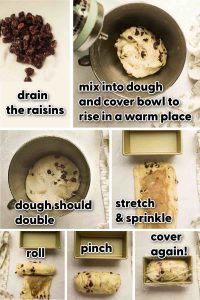Sourdough Cinnamon Raisin Bread
A soft and fluffy sourdough sandwich bread studded with raisins, with a cinnamon sugar swirl throughout.
Equipment
- Stand mixer or bread machine
- Large mixing bowl
- Rolling Pin (optional for shaping the dough)
- Clean tea towels
- Measuring cups and spoons
- Pastry brush (for brushing the egg wash)
- Thermometer (optional to check internal bread temperature)
Ingredients
Bread Dough
- ¾ cup active sourdough starter (5.8 ounces/165 grams)
- 3 cups all purpose flour (14.75 ounces/415 grams)
- 2 tablespoons brown sugar
- 1 ½ teaspoons salt
- ¼ cup butter (softened)
- ½ cup plus 1 tablespoon milk
- 1 egg
- ½ cup raisins
- water for soaking the raisins
Cinnamon Sugar Filling
- ¼ cup granulated sugar
- 1 tablespoon cinnamon
For assembly
- 1 egg (beaten)
Instructions
- Mix the dough. Mix the sourdough starter, flour, brown sugar, butter, milk, and egg in a large bowl. Keep stirring until you get a somewhat dry, rough dough. Don't worry if it seems rough now; it will get smoother when you knead it. So, no need to put more liquid in it right now. Just cover the bowl with a clean kitchen towel and leave the dough to sit out in the room for 30 minutes.
- Soak the raisins. While the dough is resting, submerge the raisins in warm water and set them aside to soak.
- Knead and add the salt. After the resting period, add the salt to the dough. Next, knead it with your hands, a mixer, or a bread machine until it gets soft and smooth, which might take around 8 to 10 minutes. If the dough seems dry and crumbles, slowly add milk, one tablespoon at a time, until it sticks together well. On the other hand, if it's too sticky, just add a bit more flour, one tablespoon at a time, until it feels right.
- Do the windowpane test and add the raisins. Mix the dough until it's ready for the windowpane test, which means taking a small piece of dough and stretching it out. If you can stretch it without it breaking and it gets see-through, it’s good to go. After that, strain out the water from the raisins you've had soaking, then mix them into the dough for another minute so they're spread out nicely.

- First rise. Lightly oil a clean bowl and place the dough inside. Then, cover with a damp tea towel and allow the dough to rise in a warm, draft-free place for 3–4 hours r until nearly doubled in size. The rise time may vary depending on the temperature and the strength of your sourdough starter.
- Shape the dough. After the first rise, press the dough down and stretch it into a rectangular shape. Make sure the shorter side matches the shorter side of your bread pan (usually about 10 inches by 6 inches for a regular pan). Making the rectangle longer will give you more swirls in the end.
- Add the sugar mix. In a little bowl, mix your sugar and cinnamon, then spread this mix all over your flattened dough. Leave about a 1-inch space around the edges without any sugar mix. Fold the top edges of the rectangle inwards, and roll the dough tightly into a log shape. Make sure to pinch the edges together so the roll stays closed.
- Second rise. Put the rolled dough with the seam facing down into a buttered bread pan. Then, cover it with plastic wrap that's also buttered. Let it sit somewhere warm for around 3 hours, or until the dough has risen 1 inch over the pan's edge.

- Bake. Preheat the oven to 350°F (175°C) toward the end of the rising time. Once the dough has risen, brush the top with the beaten egg. Bake the loaf for 40–50 minutes, until it is a deep golden brown and the internal temperature reaches 200°F (93°C).
- Cool and serve. Remove the bread from the loaf pan and let it cool completely on a wire rack before slicing. For the neatest slices, make sure the bread has cooled down completely. The bread will keep fresh at room temperature for a couple of days or you can freeze it, and it will last up to two months.
Video
Notes
Make sure your sourdough starter is bubbly and active before you begin. If it looks slow, your bread might not puff up as much. Give it some food a couple of hours before you plan to bake, so it’s ready when you are.
For the dough to come out right, use butter, egg, and milk, all at room temperature. If they’re cold, they can mess with the rising process and make the dough tough to handle.
Just soak the raisins for about 10–15 minutes to puff them up. Soaking them too long can make them mushy, and they might break apart in the dough.
After soaking, drain the raisins well and dry them off. Water left on them can make your dough sticky. Mix them into the dough carefully to avoid ripping it.
Brushing the loaf’s top with a beaten egg before baking gives it a nice golden look and a bit of shine. Just get the egg all over the top for the best look.
Wait until the bread has thoroughly cooled before cutting it. If you cut it while it’s still warm, you might crunch it, making your slices messy and ruining the bread’s shape.
Nutrition
Calories: 133kcal | Carbohydrates: 27g | Protein: 4g | Fat: 1g | Saturated Fat: 1g | Cholesterol: 22mg | Sodium: 235mg | Potassium: 85mg | Fiber: 1g | Sugar: 5g | Vitamin A: 48IU | Vitamin C: 1mg | Calcium: 27mg | Iron: 1mg
Servings: 16 slices
Calories: 133kcal